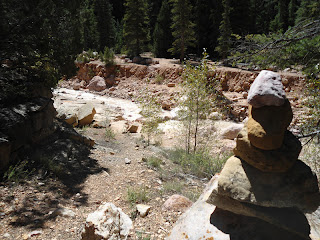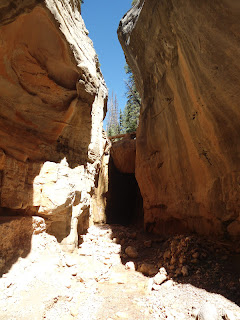Two weeks ago, Liz and I started off on what turned out to be quite the adventure. Somehow we lost the Potato Hollow trail and ended up bushwhacking our way through Long Hollow until we came to Ashdown Creek.
So this week, we decided to go back and try to figure out where we went wrong. Holli, my step-daughter, is leaving in just a couple of days to be a nanny in New York for a year so we wanted her to go on another hike with us before she left.
 |
| The turnout where the pick-up car is left |
Two cars are required for the hike. The first is dropped off at a small turn out just before the construction on the left side of hwy 14 seven miles from Cedar City. The turn out is easy to miss - in fact I drove right by it today even though I've been there the past 2 weeks.
 |
| The actual trail head, although we parked .2 miles up the road from here |
We dropped the pick-up car off there and continued up the canyon. Just past the campground and the "S turn" in the road, there is a dirt road that comes in on the left that is marked with a small wooden sign which reads, "Crystal Spring." We took our Accord up the well grated dirt road until we reached the top of the hill. This is where we left our car last time and we decided to leave it there again, even though the dirt road continues down hill for another .2 of a mile.
We started down the dirt road at 10:15 and quickly made it to the trail head. Maybe 100 yards after the trail head, we came to a fork in the trail. A small post sign indicated that the "trail" went off to the left, although no trail name was given. The main trail that we were on (which was really a grown over old 4-wheel drive road) wasn't marked at all. In studying my map, I came to the conclusion that the crossing trail was possibly the Blowhard trail.

We continued on the overgrown road through the meadow and just as the trail started to transition into a forested area, we came to a sign marking the Ashdown Wilderness.
Shortly after the trail took us through the forest, we came to a trail sign staked to a tree indicating that the "Black Canyon Trail" went off to the left and the Crystal Springs trail continued ahead. I looked on all 3 of my maps for the Black Canyon Trail but it isn't found on any of them. I'll have to go back to explore where that trail goes.
 |
| The Long Hollow and Potato Hollow split. Stay right. |
The well worn trail continues through the forest for a while and then comes to a meadow where a sign marks the Potato Hollow trail joining the Crystal Springs trail. I guess officially, this is where the Crystal Springs trail ends and the Potato Hollow trail takes over although there's no significant change in the direction or upkeep of the trail. (Note: The sign indicates that it's the blowhard trail, but the map indicates that it's the Potato Hollow trail.)
Maybe .25 of a mile later, the Long Hollow and Potato Hollow trails split, as is indicated by a big sign. The Long Hollow trail continues to follow the Long Hollow canyon, which we had been hiking in, and breaks off to the left. The Potato Hollow trail breaks off to the right and traverses up and over the small ridge to the right and then down into Potato Hollow.
At first the Potato Hollow is well defined, just as had been the Crystal Springs trail. But after only a hundred yards or so, the trail starts to look more like a game trail. At one portion of the trail it cuts back and switches back up the ridge. This is the trickiest part of the hike, and just two weeks before Liz and I missed the switch back up the ridge and continued heading straight. Eventually we caught up with the Long Hollow Trail, still thinking we were on the Potato Hollow trail, but that's another story that can be read about in the Long Hollow Bushwhack trip report.
 |
| This is the spot where the "trail" does a 180 and switches back up to the right |
Once you pass the sign indicating the Long Hollow and Potato Hollow trail splits, keep an eye out on the ridge to the right because it's actually easier to spot a cairn up there than it is to see the actual spot where the trail switches back because there is no trail at that point. There is a downed tree that has apparently been placed at the spot where the trail switches back to try to discourage hikers from going the wrong way, but with all the downed trees and brush that we had already had to hike through or over, it looks just like part of the landscape.
 |
| The ridge top between Long Hollow and Potato Hollow |
Once to the cairn up on the ridge, the trail becomes well defined once again. It climbs steeply up the ridge and the 8500+ feet of altitude take their toll, but this is just about the only ascent on the entire hike. Once to the top of the ridge, the surrounding views are beautiful. The trail then descends through a forested area down into Potato Hollow. A small meadow is encountered where there is no trail at all but if you scan the area below, you'll see a sign marked "trail" which lets you know which way to head. From here, the trail is hit and miss for a while, but there are numerous large cairns and just knowing that you have to follow Potato Hollow down to the road, means that the way to go is pretty obvious.
 |
| The dirt road as seen from the trail |
After 3.2 miles of hiking from where we parked our car, we came to the dirt road and a sign marking the Potato Hollow trail. When we got on the road we took a right, as the maps indicated we should. After maybe a tenth of a mile, right after the road turns back east, a well defined trail, marked with a sign reading "Potato Hollow Trail," breaks off on the left and heads down to the river. We decided to stay on the road and take it to the river instead because we wanted to see the old sawmill which is right across the river where the road ends. In all, we were on the road for .8 miles until we came to the river at 7730 feet in altitude.
 |
| The sawmill |
We took some pictures at the sawmill, being mindful that it's on private property, and left for our hike out down Ashdown Gorge. I tried to remember to look for the Potato Hollow trail that leads into and crosses the river, and where we entered last week when we started at the Rattlesnake Creek trail, but I missed it. We came to the Grotto, the amazing cave like area that words don't do justice describing, and had some snacks.
We continued down canyon until we came to Tom's Head which marks the confluence of Rattlesnake and Ashdown creeks. We asked Holli if she wanted to add the extra mile round trip on to see the waterfalls, but she decided not to so we continued on our way. If you have the time and the energy, I highly recommend seeing the waterfalls. I have pictures of them on my Rattlesnake Creek trip report. Seeing them is definitely worth the time and effort.
 |
| Flanigan Arch |
The route continues to follow the stream course and by this time me feet were starting to ache from being so cold, hiking in and out of the water. A little short of a mile down from Tom's Head is Flanigan Arch which can only be seen from the left bank of the river and is easily missed. A large dark colored boulder is a land mark to look for and there is a large cairn marking the view point.
From Flanigan Arch, it's not much longer until the road can be spotted in the distance. Once the road is right above you, the most unpleasant part of the hike begins. The landslide has completely covered whatever trail there might have been before and navigating the stream course is impossible because of all the brush that over hangs it. So we made our way up out of the stream and through trees, over boulders, around potholes, and in mud to get around the landslide.
Once you get to the man-made water ways, the trail climbs out of the river to the right and follows an overgrown road that will eventually take you back to the pick-up car. We made it back at 3:10 after about 8.5 miles of hiking.
 |
| The trail as it heads up the ridge out of Long Hollow right after the trail splits. |
 |
| A meadow with no trail. If you look closely in the distance on the left hand side you can see a sign making the trail |
 |
| A close up of that sign |
 |
| This is Potato Hollow. Follow the cairns or just follow this ravine down to the road. |
 |
| A blurry picture of the Potato Hollow trail that breaks off of the road. We didn't take this trail - we continued on the road so we could see the sawmill. |
 |
| Holli was determined not to get her feet wet at first. That didn't last long... |
 |
| Entering the grotto |
 |
| A view of the grotto from the side |
 |
| Tom's Head. This landmark marks the spot of the confluence of Rattlesnake and Ashdown Creeks |
 |
| Splash! Liz jumping into the water. |


































































